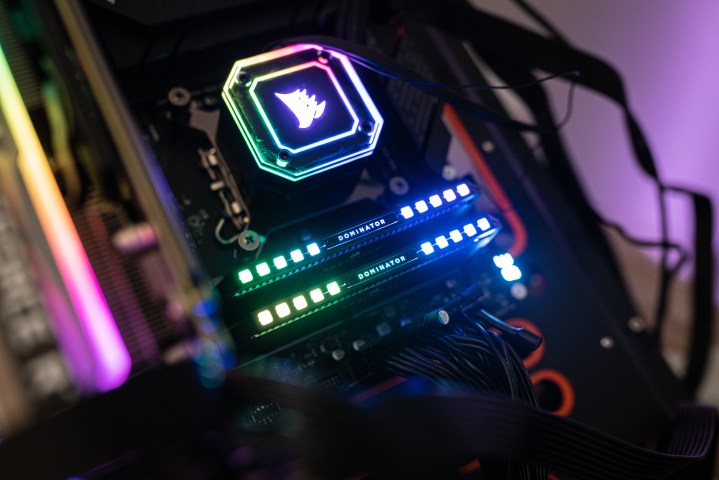Why new SSDs are melting down, and how to protect yours
PCIe 5.0 SSDs based on the Phison E26 controller are advised to be used with a cooler to run safely without any overheating issues.

 Jacob Roach / Digital Trends
Jacob Roach / Digital TrendsA wide range of new SSDs are facing overheating issues when pushed to their limits, thereby resulting in thermal shutdowns. The malfunction is specific to PCIe 5.0 SSDs based on the Phison PS5026-E26 controller inside. If you don’t have a proper cooling solution in place, you could be in for a world of trouble.
The issue was first discovered by Phoronix and TechPowerUp back in May while using the Corsair MP700 SSD. According to Phoronix, the drive started malfunctioning within a few minutes of usage, where the operating system started generating file system errors. TechPowerUp, on the other hand, faced thermal shutdown in less than two minutes. It is noteworthy that the Corsair MP700 was originally supposed to launch with a beefy heatsink. However, Corsair ended up removing the thermal solution in the final retail product.
A recent report now claims that the shutdown issue is not just limited to the Corsair MP700. German news portal Computerbase suggests that the Seagate FireCuda 540, Gigabyte Aorus Gen5 10000, and Adata Legend 970 are all potential victims. This is because all of these PCIe 5.0 SSDs make use of the same Phison E26 controller as the Corsair MP700.
Compared to PCIe 4.0 SSDs, the latest-gen PCIe 5.0 drives run hot if used without an active or passive cooler. Since PCIe 5.0 drives offer higher performance, they also consume more power, thus proper cooling is a necessity.

Phison has already given a statement to Tom’s Hardware, clarifying that all Phison E26-based SSDs are intended to be used with a heatsink, even if they are shipped without one. Additionally, most motherboards that support PCIe 5.0 include cooling solutions specifically designed for Gen5 SSDs. The company has also released a new firmware (v22.1) that addresses the issue where PCIe 5.0 SSDs throttle in a controlled manner instead of crashing.
The new firmware comes with link-state thermal throttling that reduces the PCIe interface speed (PCIe 5.0 to PCIe 4.0) to lower the temperature of the physical layer without throttling the processor clock. While this is clearly going to impact the SSD’s read and write speeds, the new firmware should offer an acceptable level of performance at high temperatures.
In case you are using any of the above-mentioned SSDs, or one that makes use of the Phison E26 controller, we highly recommend using it with a heatsink. Updating to the latest firmware is also a good way to ensure that your SSD operates safely.
Editors' Recommendations
Here’s how you could protect your RTX 4090 from melting What is PCIe 5.0? Blazing-fast PCIe 5 SSDs with 13,000MBps are almost here This new TeamGroup SSD is one of the fastest drives ever This SSD is one of the fastest we’ve seen, but you probably can’t use itA PC hardware enthusiast and casual gamer, Kunal has been in the tech industry for almost a decade contributing to names like…
Leaked image reveals future Intel exascale chips with PCIe 5.0 and DDR5 memory
Intel's next-generation Xeon processors could come with support for new technologies to make servers fast, according to the latest leaked images. Leaked schematics for an engineering sample of Intel's 4th-gen Xeon -- which has a code name of Sapphire Rapids -- indicate that the processor may add support for PCIe 5.0 and new eight-channel DDR5 memory. Support for the former would make Sapphire Rapids the first server processor to add PCIe 5.0 support, while support for the latter would bring Intel's server into memory parity with its recently unveiled Alder Lake processors, which will arrive later this year.
For its part, Intel has not confirmed any information in the leak, but Wccftech reported that the schematics posted by YuuKi-AnS show that Intel's powerful server processor can be used in high-performance computing (HPC) systems like exascale computers. In one slide deck, a configuration shows that two Sapphire Rapids processors would be paired with six Intel Xe-based graphics with unified system memory.
Faster new PCIe 5.0 standard leapfrogs the best feature of AMD’s Ryzen 3
AMD's says its new Ryzen 3 processors -- announced this year at CES 2019 -- will be the first consumer CPUs to support faster data transfer speeds. Those claims may be short lived.
Even though the newly announced Ryzen 3 will be the first processor to come to market supporting the new PCIe 4.0 standard -- current PCs are still on PCIe 3.0 -- the industry group that's responsible for the PCI specifications leapfrogged AMD's announcement by ratifying PCI Express 5.0 version 0.9. PCIe 5.0 will effectively increase the data throughput of PCIe 4.0 by twofold.
Perfect for school, this 15-inch Chromebook is on sale for $149
If you're looking for cheap Chromebook deals, look no further than Walmart. Today, you can buy the Gateway 15.6-inch Chromebook for $149, saving you $129 off the usual price of $278. It's a clearance deal so stock is likely to be very limited. Also, it's proving popular with many people before heading back to school, so you may need to be fast to avoid missing out. Here's what you need to know about it.
Why you should buy the Gateway 15.6-inch Chromebook
Even among the very best Chromebooks, it can be unusual to see a 15.6-inch screen on a Chromebook of this price. Granted, with the Gateway 15.6-inch Chromebook, you get a HD display which is a little basic but the extra room is useful compared to a 14-inch model. The Chromebook is powered by an Intel Pentium Silver processor and has 4GB of memory and 128GB of eMMC storage. Standard stuff for a typical cheap Chromebook but just what you need to get the basics done and use cloud-based apps on the move.

 Astrong
Astrong 



































